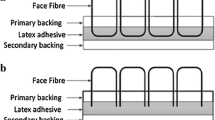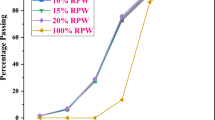Abstract
Recycling PVC wastes with conventional chemical recycling methods such as pyrolysis, gasification is not feasible due to the carbon dioxide and dioxin emmissions generated with these methods. PVC wastes can be disposed using in ready-mixed concrete which is the most commonly used building material. In this study, effects of waste PVC instead of fine aggregate and the effects of waste PVC on the concrete properties were analyzed using 0%, 30%, 35%, 40% and 45% (w/w) in the experiments. Effects of waste PVC in concrete were compared with the other waste polymer concrete in terms of mechanical, thermal and electrical properties. All waste polymers have reduced the mechanical strength of concrete as expected. Improvement rates for the splitting tensile strength for 28 days are found to be 54.46%, 48.52% and 6.93% for PP, PET and rubberized concrete, respectively, in comparison with reference concrete. For thermal conductivity, improvement rates for 40% PC, 40% PP and 40% PVC concrete are found to be 52.56%, 44.87% and 42.31%, respectively. For electrical resistivity, the highest improvement rate was determined as 136.03%, 132.38% and 105.92% for PC, PVC and rubberized concrete, respectively.












Similar content being viewed by others
References
Grause G, Buekens A, Sakata Y, Okuwaki A, Yoshioka T (2011) Feedstock recycling of waste polymeric material. J Mater Cycles Waste Manag 13(4):265–282
Kočevar G, Kržan A (2018) Recycling of an acrylate–glass fber reinforced polyester composite. J Mater Cycles Waste Manag 20(2):1106–1114
Yamada K, Tomonaga F, Kamimura A (2010) Improved preparation of recycled polymers in chemical recycling of fiber-reinforced plastics and molding of test product using recycled polymers. J Mater Cycles Waste Manag 12(3):271–274
Pickering SJ (2006) Recycling technologies for thermoset composite materials-current status. Compos Part A Appl Sci Manuf 37(8):1206–1215
Saikia N, de Brito J (2014) Mechanical properties and abrasion behaviour of concrete containing shredded PET bottle waste as a partial substitution of natural aggregate. Construction building materials 52:236–244
Hannawi K, Kamali-Bernard S, Prince W (2010) Physical and mechanical properties of mortars containing PET and PC waste aggregates. Waste Manag 30(11):2312–2320
Madandoust R, Ranjbar MM, Mousavi SY (2011) An investigation on the fresh properties of self-compacted lightweight concrete containing expanded polystyrene. Constr Build Mater 25(9):3721–3731
Gesoğlu M, Güneyisi E, Khoshnaw G, İpek S (2014) Investigating properties of pervious concretes containing waste tire rubbers. Constr Build Mater 63:206–213
Kou S, Lee G, Poon C, Lai W (2009) Properties of lightweight aggregate concrete prepared with PVC granules derived from scraped PVC pipes. Waste Manag 29(2):621–628
Şimşek B, Uygunoğlu T (2016) Multi-response optimization of polymer blended concrete: a TOPSIS based Taguchi application. Constr Build Mater 117:251–262
Şimşek B, Uygunoğlu T (2018) Thermal, electrical, mechanical and fluidity properties of polyester-reinforced concrete composites. Sādhanā 43:57. https://doi.org/10.1007/s12046-018-0847-5
Janajreh I, Alshrah M, Zamzam S (2015) Mechanical recycling of PVC plastic waste streams from cable industry: a case study. Sustain Cities Soc 18:13–20
Marzouk OY, Dheilly R, Queneudec M (2007) Valorization of post-consumer waste plastic in cementitious concrete composites. Waste Manag 27(2):310–318
Havez AA, Wahab N, Al-Mayah A, Soudki KA (2016) Behaviour of PVC encased reinforced concrete walls under eccentric axial loading. Structures 5:67–75
Scott B, Wahab N, Al-Mayah A, Soudki KA (2016) Effect of stay-in-place PVC formwork panel geometry on flexural behavior of reinforced concrete walls. Structures 5:123–130
Senhadji Y, Escadeillas G, Benosman A, Mouli M, Khelafi H, Kaci SO (2015) Effect of incorporating PVC waste as aggregate on the physical, mechanical, and chloride ion penetration behavior of concrete. J Adhes Sci Technol 29(7):625–640
Bolat H, Erkus P (2016) Use of polyvinyl chloride (PVC) powder and granules as aggregate replacement in concrete mixtures. Sci Eng Compos Mater 23:209–216
Behl A, Sharma G, Kumar G(2014)A sustainable approach: Utilization of waste PVC in asphalting of roads. Constr Build Mater 54:113–117
TS EN 12390-1 (2013) Concrete–hardened concrete experiments—sect. 1: the shape, size and other properties of the test sample and molds. Turkish Standard Institute Ankara, p 12
TS EN 12390-3 (2010) Concrete–hardened concrete experiments—Sect. 3: determination of the mechanical strength in the test specimens. Turkish Standard Institute Ankara, p 21
TS EN 12390-6 (2010) Concrete–hardened concrete experiments—Sect. 6: Determination of the splitting tensile strength of the test specimens. Turkish Standard Institute.Ankara, p 13
TS EN 12390-7 (2010) Concrete–Hardened Concrete Experiments—Sect. 7: Determination of hardened concrete density. Turkish Standard Institute. Ankara p 12
TS EN 12350-2 (2010) Concrete – Testing fresh concrete - Sect. 5: Slump test. Turkish Standard Institute. Ankara, p 9
ASTM C1113 (2013) Standard test method for thermal conductivity of refractories by hot wire (platinum resistance thermometer technique).ASTM West Conshohocken, (C1113/C1113M-09)
Şimşek B, Uygunoğlu T (2017) A full factorial-based desirability function approach to investigate optimal Mixture ratio of polymer concrete, Polym Compos. https://doi.org/10.1002/pc.24330
Wang H, Yang J, Liao H, Chen X (2016) Electrical and mechanical properties of asphalt concrete containing conductive fibers and fillers. Constr Build Mater 122:184–190
Lübeck A, Gastaldini ALG, Barin DS, Siqueira HC (2012) Compressive strength and electrical properties of concrete with white Portland cement and blast-furnace slag. Cem Concr Compos 34:392–399
Neville AM (2011) Properties of Concrete 5. ed. Pearson Education Limited UK
Şimşek B, Uygunoğlu T (2017) Multi-response optimization of ultrasonic pulse velocity and the modulus of elasticity of concrete containing polymeric wastes. J Polytech 20(4):1009–1017. https://doi.org/10.2339/politeknik.369924
Acknowledgements
This research was carried out with the support of the Scientific Research Project (MF060416B21) funded by Çankırı Karatekin University. The authors thank Çankırı Karatekin University, Scientific Research Project Management Unit (ÇAKÜ-BAP).
Author information
Authors and Affiliations
Corresponding author
Additional information
Publisher’s Note
Springer Nature remains neutral with regard to jurisdictional claims in published maps and institutional affiliations.
Rights and permissions
About this article
Cite this article
Ceran, Ö.B., Şimşek, B., Uygunoğlu, T. et al. PVC concrete composites: comparative study with other polymer concrete in terms of mechanical, thermal and electrical properties. J Mater Cycles Waste Manag 21, 818–828 (2019). https://doi.org/10.1007/s10163-019-00846-0
Received:
Accepted:
Published:
Issue Date:
DOI: https://doi.org/10.1007/s10163-019-00846-0




